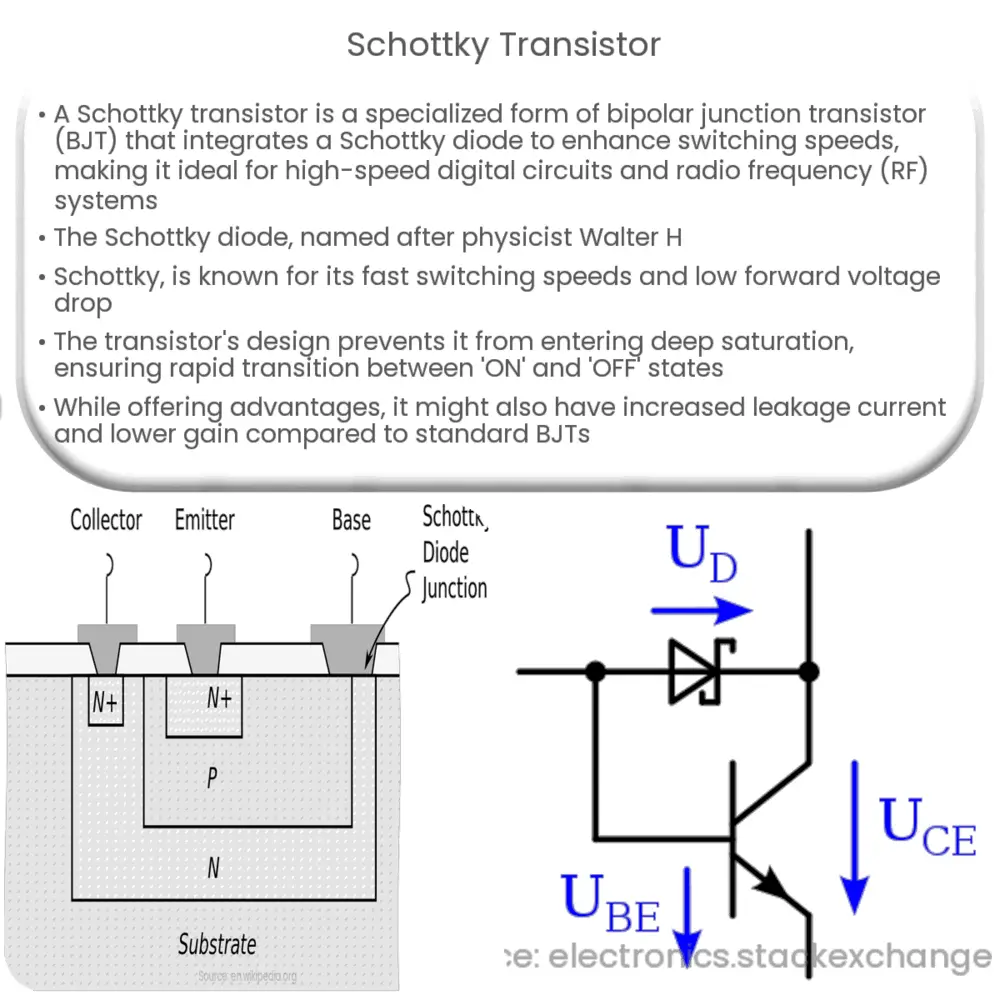Explore the Schottky transistor, its unique design, working principle, benefits, applications, and limitations in our comprehensive guide.

Introduction to Schottky Transistors
A Schottky transistor, also known as a Schottky-clamped transistor, is a unique form of bipolar junction transistor (BJT) that is optimized to mitigate certain performance limitations. The primary distinction of this device lies in the integration of a Schottky diode within its design.
The innovation of the Schottky transistor was driven by the objective to improve switching speeds of traditional BJTs, a vital aspect in various applications like digital circuits and radio frequency (RF) systems. The Schottky transistor has become a popular choice in such scenarios due to its high-speed performance.
The Schottky Diode
Understanding the Schottky transistor necessitates a basic grasp of the Schottky diode, the component that lends the transistor its name. The Schottky diode, named after physicist Walter H. Schottky, is a metal-semiconductor junction diode known for its fast switching speeds and low forward voltage drop.
- Fast Switching Speed: This is a critical aspect in applications where the diode has to alternate between the forward and reverse bias conditions rapidly. The Schottky diode’s fast switching speed results from its majority carrier conduction mechanism.
- Low Forward Voltage Drop: The forward voltage drop of a Schottky diode is typically around 0.2 to 0.3 volts. This low voltage drop results in greater system efficiency by reducing power dissipation.
Construction and Working Principle of Schottky Transistors
The Schottky transistor utilizes a unique construction that incorporates a Schottky diode into a BJT. Here’s a simplified explanation of its structure:
- The Schottky diode is connected between the base and the collector terminals of the transistor. This diode is reverse-biased during normal operation.
- In a NPN transistor, when the base-emitter junction is forward-biased, and the base-collector junction (Schottky diode) is reverse-biased, the transistor is in the ‘ON’ state. Electrons are injected from the emitter to the base, and they diffuse to the collector, causing a collector current.
This design helps to prevent the transistor from going into saturation mode, thus drastically reducing the transistor’s switching time.
The Schottky transistor’s operation relies on the unique properties of the Schottky diode. By preventing the transistor from going into deep saturation, it ensures faster transition from the ‘ON’ state to the ‘OFF’ state, improving overall performance in high-speed switching applications.
Advantages and Applications of Schottky Transistors
As we’ve established, the main advantage of Schottky transistors lies in their fast switching speeds. This advantage stems from the device’s unique design, which prevents the transistor from entering deep saturation, reducing the time needed to transition from ‘ON’ to ‘OFF’. This ability to avoid saturation also results in less stored charge and lower power dissipation, enhancing system efficiency.
- High-Speed Digital Circuits: Schottky transistors are frequently used in TTL (Transistor-Transistor Logic) circuits because of their high-speed performance. In fact, a specific variant of TTL, known as Schottky TTL or S-TTL, was developed to exploit these benefits.
- RF Systems: The quick switching times of Schottky transistors are beneficial in radio frequency systems, where they are used in mixer and detector circuits.
Potential Limitations of Schottky Transistors
While Schottky transistors have notable advantages, they are not without limitations. The inclusion of the Schottky diode can increase leakage current when the transistor is in the ‘OFF’ state. Moreover, the Schottky transistor may have a lower gain compared to a standard BJT due to the presence of the Schottky diode.
Conclusion
In conclusion, the Schottky transistor is a specialized form of BJT that incorporates a Schottky diode to provide fast switching speeds and prevent saturation. This distinctive design makes it an excellent choice for high-speed digital circuits and RF systems. Despite some potential drawbacks such as increased leakage current and lower gain, the Schottky transistor stands as an exemplary innovation in the field of electronics, highlighting the importance of thoughtful design in enhancing device performance.
As technology continues to evolve and the need for faster and more efficient devices grows, the study and application of components like the Schottky transistor will continue to be of paramount importance. It offers a remarkable example of how understanding and manipulating the properties of materials at the atomic level can lead to significant improvements in the performance of electronic devices.

